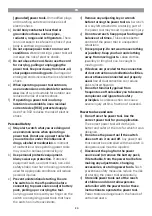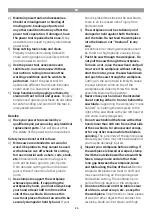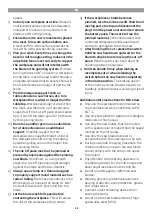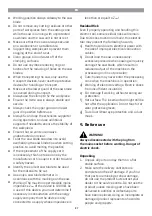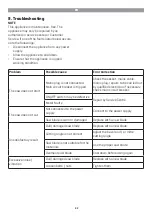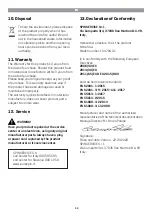
EN
29
Bevel angle adjustment (Fig. F)
1. Loosen the bevel locking knob (22) .
2. Move the operating handle (1) until the
bevel pointer (23a) aligns with the required
angle on the bevel scale (23) .
3. Tighten the bevel locking knob afterward.
Workpiece clamp (Fig. G)
The workpiece clamp (15) can be assembled
on either side of the base (13). And tighten the
workpiece clamp locking knob (17) in clockwise
direction to secure the clamp.
Use the workpiece clamp to support the
workpieces of different thickness by adjusting
the height of the bracket (15b) and plate (15e).
1. Loosen the locking knob (15c) on the
height adjustment pillar (15d) and adjust
the bracket (15b) to the required height.
2. Tighten the locking knob to secure the
bracket.
3. Adjust the height of the plate (15e) by
screwing the height adjustment knob (15a)
clockwise or anticlockwise.
4. Rotate the height adjustment knob (15a)
clockwise to secure the workpiece before
operation.
Saw blade guard check
The saw blade guard protects against
accidental touching of the saw blade and flying
chips.
To check its function, fold the saw down,
●
The saw blade guard must release the
saw blade when it swings down without
touching any other parts.
●
When the saw unit is lifted up to the initial
rest position, the saw blade guard must
automatically cover the saw blade.
ON/OFF switch (Fig. H)
1. Push forward the lock-off device (18) on
the switch first, then squeeze the on/off
switch (19) to switch the mitre saw on.
2. Release the on/off switch (19) to switch off.
Cutting /Sawing
1. Set up the mitre saw according to the
section of “setting the operating position”.
2. Place the workpiece on the turntable (12)
with one edge against the fence (7 & 14)
3. Secure the workpiece firmly with the
workpiece clamp (15)
4. Hold the operating handle (1) firmly and
push the lock-off device (18) and squeeze
the on/off switch (19). Allow the saw blade
to reach the maximum speed.
5. Slowly lower the blade to the workpiece.
6. Only apply proper feeding force. Excessive
feeding force will not increase but reduce
the performance of the saw, overheat the
blade tips and leads to the low cutting
surface/edge quality.
7. Switch the saw off and allow the saw blade
to come to a complete stop before lifting it
from the workpiece.
Mitre cutting
Mitre cutting is same as cutting, except that
the mitre angle is set to the desired angle other
than 0º.
1. Adjust the turntable (12) to the desired
mitre angle (refer to the “Mitre angle
adjustment” section). Make sure the
turntable locking knob (24) is locked firmly.
2. Follow the same instruction of “Operation-
cutting/sawing”.
Bevel cutting
Bevel cutting is same as cutting, except that
the bevel angle is set to the desired angle other
than 0º.
1. Adjust the saw blade (6) to the desired
bevel angle (refer to the “Bevel angle
adjustment” section). Make sure the bevel
locking knob (22) is locked firmly.
2. Follow the same instruction of “Operation-
cutting /sawing”.
Compound Bevel mitre cutting
This saw operation combines a mitre angle with
a bevel angle.
1. Adjust the turntable (12) to the desired
mitre angle (refer to the “Mitre angle
adjustment” section). Make sure the
turntable locking knob (24) is locked firmly.










